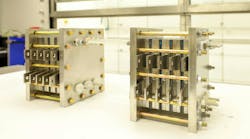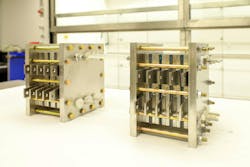Feng Jiao
Researchers at Washington University in St. Louis have developed a two-step electrochemical process to convert carbon dioxide (CO2) into acetate and ethylene.
To do this, they linked a 500 cm2 CO2 electrolyzer at 0.40 kW with a 1,000 cm2 carbon monoxide (CO) electrolyzer at 0.71 kW in series — the first converting CO2 to CO and the second CO to the multi-carbon products (Figure 1).
After over 125 hours of operation, the process yielded 98 L of 1.2 molar acetate at 96% purity. The system exhibited resilience against typical industrial impurities, such as nitrogen oxides and sulfur dioxide, maintaining high performance throughout.
The description of the work in a recent issue of Nature Chemical Engineering includes a techno-economic analysis of the process’s production of acetic acid (a salt form of acetate). This revealed the total cost was 79 c/kg, although the authors acknowledge this could be higher if a commercial system requires CO2 recovery system on the anode.
Power usage is the single largest cost, accounting for over half of the total production cost. Reducing cell voltage and improving Faradaic efficiency — as demonstrated at smaller scale in the lab — brings the cost down to 51 c/kg. The authors believe improvements in auxiliary processes such as electrolyte recovery and available tax credits would reduce the cost to 35 c/kg — well below the 68 c/kg market price.
According to project lead professor Feng Jiao of the university’s McKelvey School of Engineering, this 1,000-fold increase in scale over previous demonstrations offers a pathway to industrial feasibility.
His next target is a 10kW version, which is about a year away, given the challenges involved in this scale-up.
“Ensuring effective sealing at larger sizes and managing mass transport for both reactant delivery and product collection are critical. Quality control of electrodes and membranes, including uniform catalyst loading and maintaining chemical and mechanical stability, is essential,” he explained.
“Temperature must be carefully managed. Long-term operational stability, efficient product separation and purification, and cost considerations are also significant hurdles,”
Jiao added.
“If everything works out, we could be seeing this technology in a commercial-scale demonstration in five to 10 years."
Jiao is the co-founder of a start-up company, Lectrolyst, focused on developing the 10kW unit. The Wilmington, Delaware-based firm is also part of the Acetate Consortium and has won funding from both the Bill and Melinda Gates Foundation and the Novo Nordisk Foundation. The company previously won a $500,000 award from DARPA’s small business innovation fund for the ongoing development of its CO reduction technology.
Sponsored Recommendations
Sponsored Recommendations




